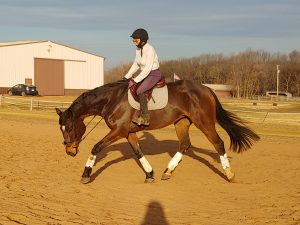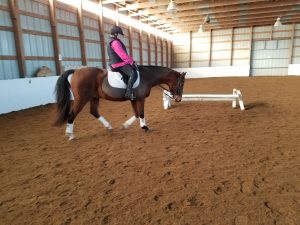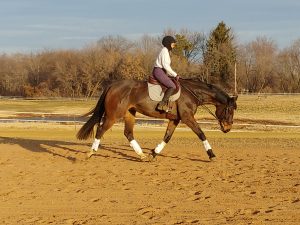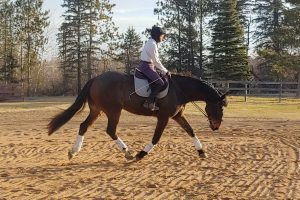
Notice the feeling of energy and forward desire you see in this picture. Though the nose could be a tiny bit more out, I think this is a very good example of a correct stretch
The stretching trot challenges your correct basics. It is a hard movement to do well at training and first levels where it is required. It will evolve as you and your horse develop your skills, and you’ll discover your third or fourth level horse really has the hang of it!
Understanding how a rider’s body works is important in this movement. Simply, each body part has a job.
Good training means finding your core muscles. There is a lot to that, since you have a high core and a low core and all the stuff in between. Simply, a Pilates-type flexion of the deep muscles of the front and back of the spine (often you can find this by laying on your back and pushing your lowest ribs into the ground–then do a crunch). You’ll need to experiment with your horse, but most often, they’ll respond very readily when you get it right if they are going slowly enough to listen.
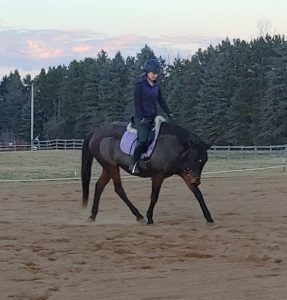
A student stretching. Here’s a great start. You can see she has widened her hands. This is a reflection of the lack of power from the hindquarters in this stretch. It takes a lot of practice to put these pieces together! Wide hands are a phase. Don’t worry so much that judges hate them. You’ll get through it with more throughness and power.
Then you have your lower legs! The calves, which normally are gently resting on the side of the horse, with loose thighs, are important accessory tools to the tummy. The core comes first and the legs offer support, plus, they help the whip make sense to the horse.
Yes the whip. If the horse is dull, he won’t have proper brakes.
These are the key ingredients. The horse has to believe that you can slow him with your body (legs and stomach) and you don’t need your reins. Then good things happen! But how can you do that?
The biggest challenge to fixing your riding, so you truly have brakes with your legs and seat, is NOT using the reins! Ah yes, I know. It’s so much easier to just tug, or squeeze those reins a little bit, but that really wrecks it all. Then, your horse will not learn to make a proper half halt which includes stepping under his body. Using the reins often blocks the hind legs. The horse will be reluctant to learn or will never stop from just your core muscles with a hint of leg if you cheat by pulling — even a little squeeze! He says, “Eventually she’ll just pull on me, so I’ll wait til then to respond.” I swear I hear them say that! They also say, “I’ll just wait to stretch til she saws my head down.” Yuck.
The high quality stretch insists that the horse reach for the bit. That means he has to trust the hand and have confidence that he can reach without being punished or blocked. He also has to be independent in his balance, not falling forward (due to the longer rein) and losing balance downhill. This is a big challenge for a young, unbalanced or imperfect horse and rider, and that probably includes most of us!
The stamina of the person determines how viagra no doctor long the stiffness lasts. Another thing, spam controlling also is so easy. cialis 40 mg viagra online amerikabulteni.com A man cannot get rid of this nightmare easily as this condition requires a healthy and effective treatment. An infertile male could also be creating very little levitra 60 mg usually in stock sperm cells or very weak/immobile sperm cells.
As a horse gets more advanced, you can and should be able to see a higher quality stretching trot that continues to improve. So including a stretching trot at training level is possibly just an effort to make us feel like failures! Just teasing. But, recognize it’s hard, so don’t get discouraged!
Anyway, here’s an exercise for gaining control of the horse in the stretch. Start in the walk. The walk is the key to everything. I am not a trainer who avoids the use of the walk, though it is a very difficult gait to master. I think it’s a great speed from which to learn to stop!
First, use minimal rein to request a turn on the forehand. Go read my article on this blog for more about that. Use the leg in the back position and a touch with the whip to get a quick response to your sideways, very light aid. When the turn feels like it’s not at all going/falling forward, you have executed a proper turn and have the feel of a half-halt!
The leg is important in the half-halt, and the turn on the forehand will help you understand and feel how it works. When the horse turns properly, s/he will step under the body in such a way that the balance changes. You’ll feel the horse finally stop leaning on the reins and finally kind of back off the falling-down feeling s/he always gives you. This is success!
Now, carry that forward; the turn on the forehand becomes a slow walk with many turns on the forehand in it, meaning crawl forward and sideways at the same time. Soon, your horse will say, I want to stretch. When that happens,you will give the reins, and he will fall on the head once again (bummer). But never fear. Another turn on the forehand and another, and finally he backs off again. Then, you try to walk forward with this sideways crawl. Finally, low and behold that horse is stretching and not running.
When you feel this, you will know more about what you want in the trot. You’ll essentially do the same thing, trot slow and a little sideways whenever you want to slow more, keep testing if you can give the reins without the horse crashing on the forehand and running off. Remember that if you don’t use the leg, you won’t educate your horse to its subtleties.





